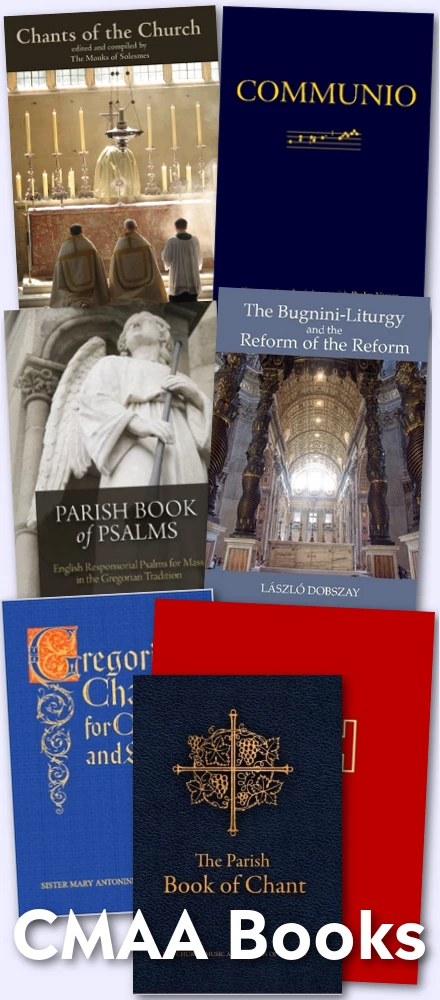Bene et Firmiter: A Short History of Reservation of the Eucharist
by Cassian Folsom, OSB, appearing in Volume 22
For the purpose of trying to discern major shifts in the theory and practice of the reservation of the Blessed Sacrament, the history of the tabernacle can be divided into four sections: the patristic period until Carolingian times, the Carolingian period until the Council of Trent, the Council of Trent to Vatican II, and Vatican II to the present.
The Patristic Period until Carolingian Times
The evidence from this early period deals with two kinds of reservation of the Blessed Sacrament: 1) the private reservation of the Eucharist in the homes of the faithful, and 2) the reservation of the Eucharist in the church for the sake of giving Communion to the sick or the dying. In the first category, the homes of the faithful, there is very little information about how or where the Eucharist was reserved, although some sources indicate that it was reverently wrapped in a piece of white linen, or placed in a special chest or container. In the case of the reservation of the Blessed Sacrament in churches, the Apostolic Constitutions, c.VIII, no.13 indicate that the deacons should bring what was left over of the Eucharistic species consecrated during the Mass to a special room called the Pastoforio: in the Oriental churches, this was situated on the south side of the altar. In the West, it had the name secretarium or sacrarium. The deacon had the keys since the administration of the Eucharist was his special charge. In this room there was a special wardrobe or chest called a conditorium. An example of this can be seen in the fifth-century mosaics of the Galla Placidia mausoleum in Ravenna. In pre-Carolingian times, however, there is no evidence for the use of the altar as a place for the reservation of the Eucharist.
Conditorium depicted in Ravenna mosaic. Photo: Holly Hayes, Art History Images, flickr.com
From the ninth century onward, the reservation of the Blessed Sacrament in the church becomes the norm, while the practice of keeping the Eucharist in the homes of the faithful disappears. This is a one of those fundamental shifts which merits greater attention. Giambattista Rapisarda offers three reasons for such a significant change in Eucharistic practice: 1) the rise of major Eucharistic controversies about the nature of Christ’s presence, starting with Paschasius Radbertus (+859) and Ratramnus (+868); 2) the spread of a different spirituality reflected in the new genre of apologetic prayers which manifested enormous respect for the Eucharist and a sense of profound unworthiness before so great a mystery; and 3) the conversion of barbarian peoples en masse with the danger of profanation of the Eucharist on the one hand and superstition on the other.
The Carolingian Period until the Council of Trent
The six or seven centuries we are dealing with in this second period contain notable developments in Eucharistic theology and practice. Mention must be made of Berengarius (+1088) and the Eucharistic controversy that raged around him; the development of a new Eucharistic piety manifested in the desire to see the Host, with the resultant introduction of the elevation first of the Host, then of the Chalice at the Consecration of the Mass; the scholastic precisions about transubstantiation; the diffusion of the feast of Corpus Christi; the decline in the reception of Communion, and so on. Some of these factors contribute to new ways of reserving the Eucharist (the Sacrament-towers, for example). At other times, the force of custom results in the retention of more traditional forms. Righetti distinguishes five basic ways of reserving the Blessed Sacrament during this period:
1) Propitiatorium: a container or small chest which was placed on the altar; hence a kind of portable tabernacle. The Fourth Lateran Council (1215-1216) prescribed that it should be locked and kept secure. This system was rather widespread in Italy in the thirteenth and fourteenth centuries.
2) Sacristy: In many places, the Eucharist was kept in the sacristy, in some kind of special chest or cupboard. In many places, this practice continued until the Council of Trent.
3) Eucharistic dove: around the eleventh century this system was used: a metal dove (symbolizing the Holy Spirit), hollow, of modest proportions, which was suspended over the altar from the ciborium (if there was one), or on a small table next to the altar. This system was frequently used in France and England, but rarely in Italy.
Thirteenth century Eucharistic Dove from Limoges, France. Photo: The Walters Art Museum, Baltimore, MD
You can read the remainder here.

.jpg)




















